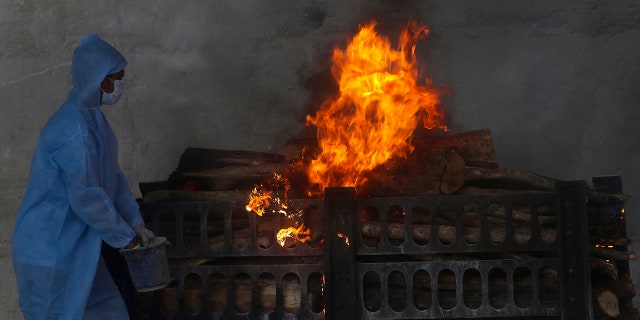
India’s health care system crumbling under massive COVID-19 outbreak
India is seeing 350,000 coronavirus cases and thousands of deaths per day; Trey Yingst reports on the crisis.
India’s coronavirus death toll topped 200,000 Wednesday with no indications of slowing down as shipments of foreign aid arrived in an effort to supplement dwindling medical supplies. The help, at least one official worried, will not address the thousands of patients turning up at already overrun medical facilities where staff is foregoing sleep and their own health in an effort to provide treatment.
“The current wave is particularly dangerous,” Delhi Chief Minister Arvind Kejriwal told Reuters. “It is supremely contagious and those who are contracting it are not able to recover as swiftly. In these conditions, intensive care wards are in great demand.”

April 19, 2021: Health workers prepare to take out bodies of six victims of COVID-19 from an ambulance for cremation in New Delhi, India.
(AP Photo/Manish Swarup)
Several countries have pledged oxygen, medical supplies and even vaccine doses in an effort to combat India’s crisis, which has seen over 300,000 new cases added daily for nearly a week straight. But the country is also lacking personnel to treat these ailing patients.
“Unfortunately, beds do not treat patients – doctors, nurses and paramedics do,” Devi Shetty, a cardiac surgeon and chairman of Narayana Health chain of hospitals, told Reuters.

April 14, 2021: People wearing masks as a precaution against the coronavirus stand in queues to board trains at Lokmanya Tilak Terminus in Mumbai.
(AP Photo/Rafiq Maqbool)
In an update on the state of the pandemic Tuesday, President Joe Biden said he had spoken to Indian Prime Minister Narendra Modi about the issues the country is facing and that officials were working to ship vaccines over. Late last week federal officials said the U.S. was also looking into sending raw material and additional supplies.
According to India’s Ministry of Health, nearly 150 million doses of COVID-19 vaccine have been administered thus far, but the eligibility has not been opened to all 1.3 billion people. Currently, India is only vaccinating those over age 45. The country is relying on two vaccines for their rollout, namely the AstraZeneca jab and Covaxin, which is manufactured by Bharat BioTech Limited.

April 12, 2021: Naked Hindu holy men take holy dips in the Ganges River during Kumbh Mela, or pitcher festival, one of the most sacred pilgrimages in Hinduism, in Haridwar, northern state of Uttarakhand, India.
(AP Photo/Karma Sonam)
SOS MESSAGES, PANIC AS VIRUS BREAKS INDIA’S HEALTH SYSTEM
India is a major producer of the AstraZeneca jab, but has turned its attention elsewhere to address the crisis at home which in turn has hampered exports that other regions were relying on, such as Africa. The export ban is also a major blow to the COVAX initiative, which had relied on vaccine supply coming from India to supply dozens of low-income countries with jabs.

April 5, 2021: India’s election authorities announced voting in five states starting massive campaign rallies and roadshows by Prime Minister Narendra Modi, Home Minister Amit Shah as well as opposition politicians with tens of thousands of supporters with no masks and social distancing.
(AP Photo/Bikas Das)
But as the country’s new cases surge to historic highs, it’s unclear as to when India will be able to resume supplying COVAX with vaccine as it grapples with inoculating its own population. Officials had aimed to vaccinate 300 million by this summer, but with resources and medical staff already strained, the goal now seems distant.
“To put it in perspective, there is almost as many cases globally last week as in the first five months of the pandemic,” WHO Director-General Tedros Adhanom Ghebreyesus said this week. “We must turn the tide quickly.”

April 19, 2021: Empty tankers are loaded on a train wagon at the Kalamboli goods yard in Navi Mumbai, Maharashtra state, India, before they are transported to collect liquid medical oxygen from other states.
(AP Photo/Rafiq Maqbool)
On the messaging front, in recent days India’s health officials have been pushing people to wear masks, a change in town after allowing thousands to gather for religious festivals and campaign rallies. Modi had declared victory against the virus in January. Experts have blamed officials’ lax attitude toward the virus for the situation they currently find themselves in. When the case rates were stable, the country should have been stockpiling supplies to stave off another wave, one said.

April 15, 2021: A municipal worker in personal protective suit performs last rites during the cremation of a COVID-19 victim in Vasai, on the outskirts of Mumbai, India.
(AP Photo/Rafiq Maqbool)
“Most importantly, they should have looked at what was going on in other parts of the world and understood that it was a matter of time before they would be in a similar situation,” Dr. Krutika Kuppalli, assistant professor of medicine in the division of infectious diseases at the Medical University of South Carolina.
On Twitter, the country’s ministry of health sent out several mask-related tweets and attempted to debunk questions surrounding vaccine safety. A tweet sent Wednesday urged people to “wear masks all the time.”
The Associated Press and Reuters contributed to this report.
Source: Read Full Article






